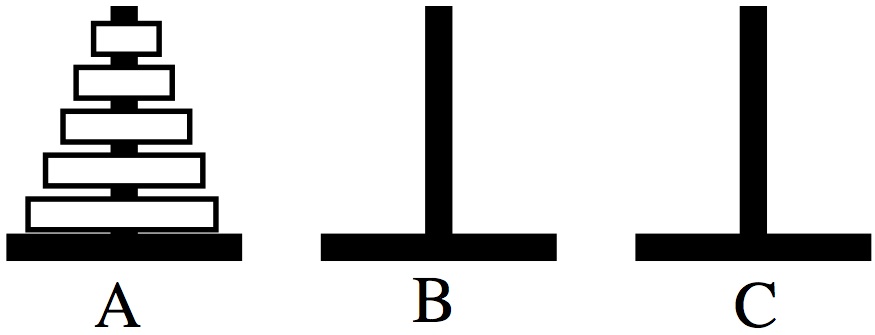1
2
3
4
5
6
7
8
9
10
11
12
13
14
15
16
17
18
19
20
21
22
23
24
25
26
27
28
29
30
31
32
33
34
35
36
37
38
39
40
41
42
43
44
45
46
47
48
49
50
51
52
53
54
55
56
57
58
59
60
61
62
63
64
65
66
67
68
69
70
71
72
73
74
75
76
| #include <iostream>
#include <unordered_map>
using namespace std;
void move(int num, char frompeg, char topeg)
{
cout << "Move disk " << num << " from peg " << frompeg << " to peg " << topeg << endl;
}
unordered_map<int, int> calculate_towers_split_values(int num)
{
unordered_map<int, int> move_four; // numbers of move when using four peg
unordered_map<int, int> move_three; // numbers of move when using three peg
unordered_map<int, int> split_values; // j using four peg, i-j using three peg
// calculate moves when using three peg
move_three[1] = 1;
for (int i = 2; i <= num; ++i)
{
move_three[i] = 2 * move_three[i - 1] + 1;
}
// known four peg moves
move_four[1] = 1; move_four[2] = 3;
split_values[1] = split_values[2] = 0;
// start moving
for (int i = 3; i <= num; ++i)
{
int min_move(move_three[i]);
int moves(move_three[i]);
int j_value(0);
for (int j = 1; j < i; ++j)
{
// move j to the fourth peg, i-j to the third peg, move j back to the third peg
moves = 2 * move_four[j] + move_three[i - j];
if (min_move > moves)
{
min_move = moves;
j_value = j;
}
}
move_four[i] = min_move;
split_values[i] = j_value;
}
// move_four[num] is the required minimum number
return split_values;
}
void towers_three(int num, char frompeg, char topeg, char auxpeg)
{
if (num < 1)
return;
towers_three(num - 1, frompeg, auxpeg, topeg);
move(num, frompeg, topeg);
towers_three(num - 1, auxpeg, topeg, frompeg);
}
void towers(int num, char frompeg, char topeg, char auxpeg, char aux2peg, const unordered_map<int, int>& split_values)
{
if (num < 1)
return;
int split_value(split_values.at(num));
towers(split_value, frompeg, aux2peg, auxpeg, topeg, split_values);
towers_three(num - split_value, frompeg, topeg, auxpeg);
towers(split_value, aux2peg, topeg, frompeg, auxpeg, split_values);
}
int main()
{
int num;
cout << "Enter the number of disks : ";
cin >> num;
cout << "The sequence of moves involved in the Tower of Hanoi are :" << endl;
unordered_map<int, int>split_values(calculate_towers_split_values(num));
towers(num, 'A', 'C', 'B', 'D', split_values);
system("Pause");
}
|

